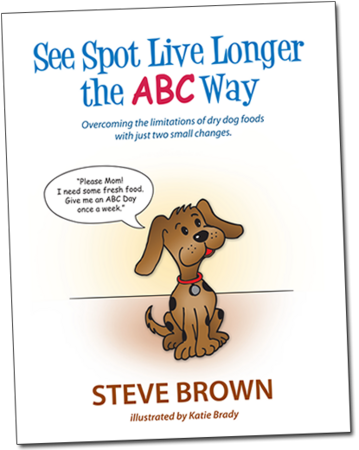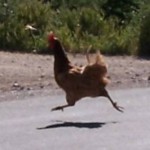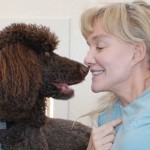 Steve Brown is my go-to expert when I have questions about dog food. He’s the originator of the first frozen commercial raw-meat diet for dogs, Steve’s Real Food (he’s since sold the company) and the author of three books, one of which I want to tell you about today, See Spot Live Longer the ABC Way: Overcoming the limitations of dry dog food with just two small changes.
Steve Brown is my go-to expert when I have questions about dog food. He’s the originator of the first frozen commercial raw-meat diet for dogs, Steve’s Real Food (he’s since sold the company) and the author of three books, one of which I want to tell you about today, See Spot Live Longer the ABC Way: Overcoming the limitations of dry dog food with just two small changes.
I’ve been conferring with Steve ever since Sadie was a puppy and suffered from regular bouts of diarrhea and vomiting during the first year of her life. He helped Sadie and me get on track with a diet that’s been working fabulously for her. I wrote about our excursion through the wild and wooly world of doggie diets in a previous post, “What’s a Dog to Eat?”
This time I called Steve with a let’s-get-real conundrum put to me by my friend, Kathy. She said “I know feeding my dogs a fresh food diet would be best. But, I have four dogs! I don’t have the time, money, or inclination to prepare meals for them. I don’t even make meals for myself. I eat take-out and feed Casey and the gang premium kibble. Still, I grill the occasional salmon steak for my dinner, and I’d like to do a little something more for my guys, but what?”
When I called Steve with Kathy’s question I had no idea that he had recently released a new e-book in which he addresses this very issue. I was expecting our conversation to result in few tips I could pass on to Kathy, but a book? What a nice surprise.
Full disclosure: Steve suggested I download See Spot Live Longer the ABC Way: Overcoming the limitations of dry dog food with just two small changes at no cost. I did and here’s what I think. It’s a great resource for people who feed kibble, even top-of-the-line kibble.
Steve’s underlying assumption is that in a perfect world we would feed our dogs an ancestral diet comprised of whole, fresh foods. Some of us do exactly that or something close to it. Many of us, though, 90% according to Steve, are like my friend Kathy who feeds her dogs kibble.
How can Kathy kick it up a notch, to borrow a phrase?
Steve suggests overcoming the limitations of dry dog food by making two small changes:
- Make one day a week “ABC day.”
- Use dry foods wisely.
ABC Day
You’re probably wondering what on earth is an ABC Day? It ‘s the one day a week that you feed your dog whole foods in place of their regular kibble. The ABC menu consists of sardines, fresh meat, eggs, and left over vegetables like broccoli stalks, bruised outside leaves of romaine lettuce, watermelon rinds, and other goodies.
What does ABC stand for?
(A) ADD high-quality protein
(B) BALANCE fats
(C) COMPLETE nutrition with nutrients available only in fresh foods.
In addition to quality protein and other fresh foods, Steve is all about feeding your dog healthy fats from whole foods like sardines and eggs, whenever possible, and making sure the variety of fats fed are balanced. In my experience, Steve’s careful attention to fats is missing from most discussions about dog food, homemade or processed.
Best of all, Steve provides easy-to-follow, simple recipes combining protein, fats, and veggies. He suggests portion sizes for dogs of specific weights, and advises you on how to vary the proportions of protein and fats depending on the type of kibble you normally feed. How cool is that?
It’s important to note, that the ABC recipes are intended to be fed only once a week in combination with a regular processed food diet.
If you want to feed your dog a whole food diet more often than once a week then I suggest you look at Steve’s second most recent book, Unlocking the Canine Ancestral Diet. It’s one of three books highly recommended by Mary Straus in “Read All About It: The best books on feeding your dog a homemade diet,” published in the March 2011 issue of the Whole Dog Journal (Volume 14, Number 3).
Use Dry Foods Wisely
I love this tip! Steve is not merely suggesting that you buy expensive, premium kibble and be done with it. In fact, he’s not even a fan of the highest priced brands. He’s all about storing and using recently manufactured kibble properly so you avoid rancid fats, vitamin and mineral loss, and contamination that can occur with poorly used dry foods.
For example, Steve suggests buying a recently produced, basic kibble—no fish, fish meal, fish oils, or other special ingredients like probiotics and glucosamine all of which go bad a short time after manufacturing. It’s healthier for your dog, and probably less expensive in the long run, if you add them separately yourself. And, as for the fish oil? Try feeding your dog a can of whole sardines packed in water once or twice a week, which, if you go the ABC route, your dog will get on his fresh, whole food day.
Steve also suggests buying kibble in small quantities and using it up quickly to preserve freshness and nutritional value. He wants your dog to get the most nutrition for your money. That’s what he means by “using dry foods wisely.”
A Few Other Things I Like about this Book
See Spot Live Longer the ABC Way is short, easy to read, and beautifully illustrated. Steve has distilled complicated nutrition science, some of which he wrote about in great depth in Unlocking the Canine Ancestral Diet, into easy-to-digest, tantalizing tidbits of common sense.
You can download See Spot Live Longer the ABC Way right now for $4.95 by clicking here.
Unlocking the Canine Ancestral Diet is also available at Steve’s website, See Spot Live Longer.
Bon appetit!
Tags: Ancestral diet, Balance fats, Kibble, Mary Straus, Overcoming the limits of dry dog food with just two small changes, Premium kibble, Sardines for dogs, See Spot Live Longer, See Spot Live Longer the ABC Way, Steve Brown, Unlocking the Canine Ancestral Diet, What's a Dog to Eat, Whole Dog Journal












